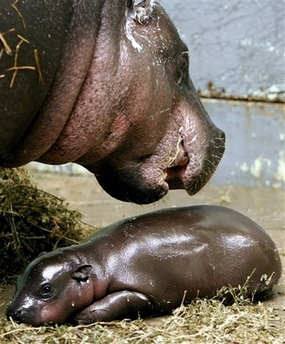Cryptozoology Animal of Discovery: Pygmy Hippopotamus
Posted by: Loren Coleman on July 1st, 2007

(Photo by Jacques Brinon)
Posting a baby picture is always a good idea on a Sunday on the first day of the month.
Here, Anais, the mother hippo, keeps an eye on her son Aldo, a three-week-old pygmy hippopotamus, (Choeropsis liberiensis), at the Vincennes zoo, outside Paris, on Tuesday, June 26, 2007.
Aldo looks, eats and takes it easy like a hippopotamus. But he is only about as big as a human baby, at 21 inches.
This pygmy hippopotamus, born on June 5, is one of only a few dozen in Europe, bred in a special program to boost the rare species, since less than 3000 now live in the wild. His older brothers, now 7 and 6 years old, live in Spain and Britain. The fact that Aldo is a male is good news to the European breeding program. Since the project started in the early 90s, there have been 46 males born and 66 females. Aldo is the 47th male of the species in captivity.
The pygmy hippopotamus, as I have mentioned before, is a good example of a little-remembered cryptozoological success story.
The account begins with Karl Hagenbeck, a famous German animal dealer, who established a zoological garden near Hamburg, the prototype of the modern open-air zoo. In 1909, Hagenbeek sent German naturalist-explorer Hans Schomburgk to Liberia to check on rumors about the nigbwe, a “giant black pig.”
After two years of jungle pursuit Schomburgk finally spotted the animal 30 feet in front of him. It was big, shiny, and black, but the animal clearly was related to the hippopotamus, not the pig. Unable to catch it, he went home to Hamburg empty-handed.
Finally, in 1912, Schomburgk returned to Liberia and, to the dismay of his critics, captured a pygmy hippopotamus on March 1, 1913, and then returned to Europe in August with five live pygmy hippos.
About Loren Coleman
Loren Coleman is one of the world’s leading cryptozoologists, some say “the” leading living cryptozoologist. Certainly, he is acknowledged as the current living American researcher and writer who has most popularized cryptozoology in the late 20th and early 21st centuries.
Starting his fieldwork and investigations in 1960, after traveling and trekking extensively in pursuit of cryptozoological mysteries, Coleman began writing to share his experiences in 1969. An honorary member of Ivan T. Sanderson’s Society for the Investigation of the Unexplained in the 1970s, Coleman has been bestowed with similar honorary memberships of the North Idaho College Cryptozoology Club in 1983, and in subsequent years, that of the British Columbia Scientific Cryptozoology Club, CryptoSafari International, and other international organizations. He was also a Life Member and Benefactor of the International Society of Cryptozoology (now-defunct).
Loren Coleman’s daily blog, as a member of the Cryptomundo Team, served as an ongoing avenue of communication for the ever-growing body of cryptozoo news from 2005 through 2013. He returned as an infrequent contributor beginning Halloween week of 2015.
Coleman is the founder in 2003, and current director of the International Cryptozoology Museum in Portland, Maine.










Like I said in another thread, sometimes what the local people say they are seeing is based on a real animal and it often looks like what they say it looks like. Even if it is a type of tiny hippo and not a pig, the basic descriptions of the two would be similar. Native stories are not to be discounted out of hand. This story shows what I think is possibly going to happen with other cryptids out there and shows how critics can be wrong. These sightings made of this thing were reliable, and I think this could be true of other cryptids seen throughout the world. It is interesting that he spent two years in hot pursuit just to get a glimpse of the thing.
I agree with Mystery Man that native stories should not to be discounted out of hand. However, no one should ever take their stories as gospel.
Jack Rabbit once wrote an article in Ben Roesch’s “Cryptoozology Review” entitled, “Native and Western Eyewitness Testimony in Cryptozoology.” It has been reprinted in Eberhart’s “Mysterious Creatures: A Guide to Cryptozoology.” In it, Rabbit presented a very persuasive argument that native observations have the same level of inaccuracy as is the case with “westerners.” Ergo, keep an open mind, but caveat emptor as well.
Nice news about the pygmy hippos. Better a future in zoos than extinction.
Very nice to see people care enough to try and keep these hippos for generations of our kids to enjoy.
Corrick- Exactly. This is the interesting aspect of native accounts. Some might be real animals made out to be something supernatural, and others could be complete fabrications, like boogie men or ghost stories. I agree that these stories should not always be taken at face value, but they should be considered. Obviously, as in the case of these hippos and other animals discovered in similar fashion, there can be something to the stories after all.
No argument here, Mystery Man. I just feel many people overestimate the accuracy and knowledge of native people about their local fauna.
I remember when I was a little kid and first saw one of these guys in the circus. It quickly became my favorite animal, lol. Who knows, maybe one day one of my kids will have the same experience with one of our current cryptids.